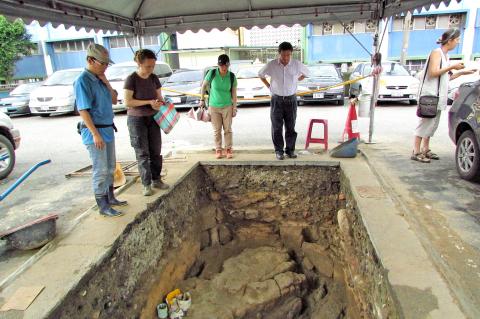An archeology team has uncovered the foundations of a Spanish chapel on an island off northern Taiwan.
Scientists said that it is an important discovery which sheds light on the history of the European colonial era during the 17th century.
The chapel was part of the Fort San Salvador complex on Heping Island (和平島) in a strategic position at the mouth of Keelung harbor and was built by the Spanish during their brief occupation of northern Taiwan more than 300 years ago.

Photo: Lu Hsien-hsiu, Taipei Times
The excavation is an international collaboration between the Academia Sinica, headed by project leader Tsang Cheng-hwa (臧振華), and an archeological research team from Spain.
Tsang, a research fellow at Academia Sinica’s Institute of History and Philology, said three corners of the chapel’s foundations were uncovered at the dig, which is taking place at a parking lot on the island.
He added that skeletal remains of two males were found at the site, one complete skeleton and another which was incomplete. The remains were judged to be contemporaneous with the fort complex.
“Right now we are not sure if the remains belong to the Spanish, or the Formosan Aborigines who were the main inhabitants of the northern coast during that time. So DNA tests will be conducted to determine their origin... It could turn out that these are the oldest evidence of the Spanish occupation yet found in Taiwan,” Tsang said.
Tsang said the dig enabled the team to determine the exact location of the chapel and it correlates with the position shown on maps of the period.
The team found that the Spanish garrison used materials they found on the island to build the chapel, as a section of the wall matched rocks found in nearby hills.
When excavating deeper around the chapel site, the team dug up much older archeological relics dating back to 2,500 to 3,000 years ago, including stone tools, pottery pieces and decorative items made from Taiwanese jade.
“This indicated that ancient civilizations were active on Heping Island and in the whole northern coastal area more than 3,000 years ago. Due to these recent finds, we will expand our excavation efforts around Fort San Salvador in the coming years, because these are important Taiwanese cultural treasures,” Tsang said.
The fort was a key stronghold during the brief Spanish occupation of northern Taiwan in the 17th century.
In 1626, Spain dispatched a fleet of warships from Manila, and sailed to Quelang — the old name for Keelung — as the fort was built that year.
For its defensive fortifications and firepower, at one time Fort San Salvador had 27 copper cannons and six iron cannons, according to Spanish documents.
After some years of battling for trade concessions and colonial holdings, in 1642 Spain ceded the fort to the Dutch, who renamed it Fort Noord-Holland.

Beijing could eventually see a full amphibious invasion of Taiwan as the only "prudent" way to bring about unification, the US Department of Defense said in a newly released annual report to Congress. The Pentagon's "Annual Report to Congress: Military and Security Developments Involving the People's Republic of China 2025," was in many ways similar to last year’s report but reorganized the analysis of the options China has to take over Taiwan. Generally, according to the report, Chinese leaders view the People's Liberation Army's (PLA) capabilities for a Taiwan campaign as improving, but they remain uncertain about its readiness to successfully seize

Taiwan is getting a day off on Christmas for the first time in 25 years. The change comes after opposition parties passed a law earlier this year to add or restore five public holidays, including Constitution Day, which falls on today, Dec. 25. The day marks the 1947 adoption of the constitution of the Republic of China, as the government in Taipei is formally known. Back then the Chinese Nationalist Party (KMT) governed China from Nanjing. When the KMT, now an opposition party in Taiwan, passed the legislation on holidays, it said that they would help “commemorate the history of national development.” That

Taiwan has overtaken South Korea this year in per capita income for the first time in 23 years, IMF data showed. Per capita income is a nation’s GDP divided by the total population, used to compare average wealth levels across countries. Taiwan also beat Japan this year on per capita income, after surpassing it for the first time last year, US magazine Newsweek reported yesterday. Across Asia, Taiwan ranked fourth for per capita income at US$37,827 this year due to sustained economic growth, the report said. In the top three spots were Singapore, Macau and Hong Kong, it said. South

HORROR STORIES: One victim recounted not realizing they had been stabbed and seeing people bleeding, while another recalled breaking down in tears after fleeing A man on Friday died after he tried to fight the knife-wielding suspect who went on a stabbing spree near two of Taipei’s busiest metro stations, Taipei Mayor Chiang Wan-an (蔣萬安) said. The 57-year-old man, identified by his family name, Yu (余), encountered the suspect at Exit M7 of Taipei Main Station and immediately tried to stop him, but was fatally wounded and later died, Chiang said, calling the incident “heartbreaking.” Yu’s family would receive at least NT$5 million (US$158,584) in compensation through the Taipei Rapid Transit Corp’s (TRTC) insurance coverage, he said after convening an emergency security response meeting yesterday morning. National